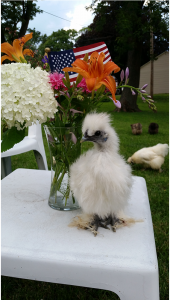Yesterday while on BackyardChickens.com, a member asked the silkie group how everyone took such amazing photos. She said that every time she tries to take photos, they don’t turn out very well. I don’t think that I take amazing photos I don’t know that I take amazing photos, but I’ve learned some things over the past year while trying to photograph my chickens.
6 tips for photographing chickens:
#1 Lighting
I have found pictures taken at dusk turn out the best for me. I think it is because there is no direct light but it is still bright outside. I assume the same would be true if you are an early bird and took pictures at dawn, but wouldn’t know personally. The way may yard is situated, with our side lot to the west of the house, I get filtered light in the evening just before sunset and pictures turn out much better than when I am taking them during the day. I also like photographing chickens around dusk as I don’t have to deal with shadows getting in the way.
#2 Treats
I try to get the birds to look up at me, instead of face down/tail up by bribing them with treats. For our Christmas card in 2013, I posed three chickens and used some club crackers leftover from Thanksgiving to get the birds to sit still and look up. You can see a cracker in front of the white chicken below. I will also try to get the chicken’s attention by holding a treat above their heads or snapping my fingers above their heads. Chickens love to eat bugs and I think the quick movement and sound of fingers snapping makes them think their might be a bug up there for them to eat.

#3 Multiple Shots
I can take 10 pictures and I might get 1 that is usable. For the Christmas card photo shoot, I took close to 100 photographs and ended up using only 1, but I had several options to choose from. Once I make sure the camera lens is focused on the bird’s face, I will keep taking photographs without looking at them, hoping that one is good. Once the chicken moves, or I feel like I must have gotten a good shot, I will review the pictures to make sure I got at least 1 usable photograph. The pullet in front of the vase of flowers [first, bottom] had her picture taken at least 10 times before I got this one. She was hen raised and isn’t as comfortable in front of the camera as she is just sitting on my lap. The pair of Mille Fleurs [second, bottom] were happy to pose for me at my cousin’s farm, I ended up taking 30 photographs of them to get this shot with a peacock in the background.
#4 Videos
Sometimes I’ll end up taking a video and just take a screenshot to get a good picture. It is more difficult to get a clear picture this way, but in some situations it is impossible to take enough pictures to get one good one without making a video.
#5 Find your ham
I have a bird (my BYC avatar actually) that hears me pull out the camera and is there, waiting to pose for me. I have a very small flock (currently 9 silkies) and only 1 ham; chances are good you might have one chicken that would love to pose for you if given the chance and some treats.
I was trying to get pictures of honeybees in our yard one day, and when I pulled out the camera, Toppy, our ham for the camera, blocked the entire shot. I love his expression, as if he is thinking, “why aren’t you taking photographs of me and instead focusing on these little insects?”. I actually take a honeybee photograph for each day and post it across all our social media outlets for CollegeBeekeeper.com. So yes, chickens aren’t the only common subject for my photographs.
What’s even funnier is that I was looking at pics from last year when this guy was still a chick, and here he did the same thing! I was trying to get group shot of the birds in the back of their coop, and he steps right in front of the camera-blocking off the other chickens and in the worst light.
#6 Get level
If I am photographing chickens, I am on the ground, usually laying and rolling around the grass as they move around me. If I put them on a surface, I sit up and make sure I am level. I have also found that I tend to get too close to subjects (like the silkie pullet in front of the vase above) and always need to take a step or 2 back. I used an iPhone 4s (5 megapixels) for the photographs from 2013 and use a Samsung Galaxy S5 (16 megapixels) in 2014.
That’s it for my tips on photographing chickens. Hope this helps other backyard chicken keepers take amazing photos of chickens!



